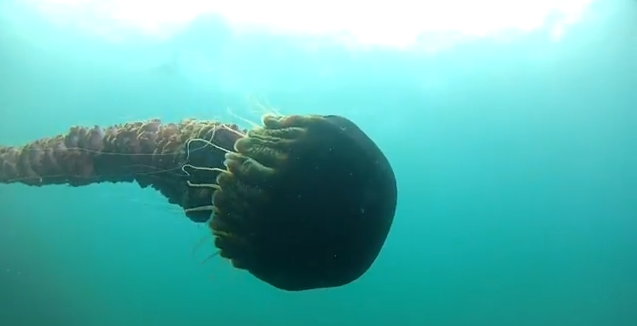
The Fourth of July was an exciting day and not just because it was America's Independence Day. At a Southern California beach, a rare Black jellyfish stung several swimmers who were in the water enjoying the holiday.
It seems that this isn't the first occurrences of these rare jellyfish attacking swimmers. Last week, the Washington Post reported that swimmers came out of the water at Thousand Steps Beach in Laguna Beach with dark membranes still clinging to their legs and bodies. The swimmers suffered from rare jellyfish stings. From the dark hue of the remaining membrane, they are believed to have been the Black jellyfish.
Although the rare jellyfish's sting is painful, it isn't life threatening. "They are not likely to kill you. They are not a deadly jellyfish, but they can give you a painful sting," Richman said, according to the International Business Times.
Black jellyfish, also known as Chrysaora achlyos, have black tentacles that can grow up to 30 feet long. The impressively long tendrils of the rare jellyfish are also quite useful, instead of seemingly hanging below the wiggly mass that serves as a jellyfish's body, these long tendrils serve as indicators. Coated with thousands of microscopic nematocysts, the rare jellyfish waits for a trigger to be set off before stinging its prey. If meaning to kill its prey, the jellyfish will then disperse its toxins which can prove deadly in small prey. As for humans who come in contact with the toxin filled tendril, a painful stinging sensation will occur and is said to last up to 40 minutes.
According to Nigela Hillgarth of Birch Aquarium in La Jolla, the rare species of jellyfish was identified in 1997, and has only recently resurfaced in Southern California. The large animal has not been seen in waters since the 1920's. Which has scientists questioning why these massive jellyfish have returned? Headlines & Global News believe that the increased number of Black jellyfish could be a direct result of climate/eco-system change. "The increased number of nettles could be an indication that humans have changed the condition of the oceans by increasing the amount of organic material which provides more nutrients for multiple types of aquatic life."
And while packing a painful sting, the rare Black jellyfish is beautiful and stunning. Those who witnessed the phenomenon were either left in awe of the sea creature or for the less fortunate, painful stings. "In 30 years of diving and fishing off San Diego, I've seen a lot of cool things and this ranks up there as one of them," Joe Richman, a kayaker who spotted the rare jellyfish, said.
And while this may shock you, if you do unfortunately suffer a jellyfish sting, you should NOT urinate on yourself. Instead first get out of the water immediately, then remove stingers from infected area, if you did not remove all active stingers pour white vinegar over the area which will neutralize the venom. Next apply a paste of baking soda and water which will soothe the sting, finally to ensure all venom is deactivated take a very hot shower and soothe any remaining skin irritations with antihistamine pills and cream. So remember don't panic and don't pee on yourself!
RELATED:
Ibrahim Yucel, Turkish Man, Locks His Head In A Cage To Avoid Smoking Cigarettes [VIDEO]
Golden Corral Dumpster: Footage Exposes Unsanitary-Looking Trays Of Meat Stored Outside Near Trash [VIDEO]
Roswell UFO Incident, Google Celebrates 66th Anniversary With Interactive Alien Doodle
© 2025 Latin Times. All rights reserved. Do not reproduce without permission.





